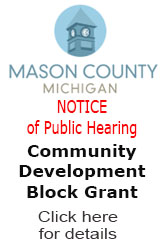
The Clarence E. Hemingway family, Oak Park, Illinois, ca. 1917. Left to right: Dr. C. E. Hemingway, Carol, Grace Hall Hemingway, Ernest, Leicester, Ursula, Sunny, Marcelline.
 Did Hemingway spend the night in Scottville?
Did Hemingway spend the night in Scottville?
By Rob Alway, Editor-in-Chief.
In the summer of 1917, 17-year-old Ernest Hemingway (1899-1961), along with his parents, Dr. Clarence “Ed” Hemingway (1871-1928) and Grace Ernestine (Hall) Hemingway (1872-1951), and his 2-year-old brother, Leicester Hemingway (1915-1982), made their way through Mason County, on a road trip to their cottage on Walloon Lake in Emmet County.

Ernest Hemingway in 1916, 16-years-old.
A 1999 article in Michigan History Magazine, published by the Historical Society of Michigan, talks about the first time the Hemingway family decided to drive to their cottage from their home in Oak Park, Ill.
“Construction of the Hemingways’ cottage began in 1899, the year Ernest was born. That year and for the next 16 seasons they traveled by boat across Lake Michigan from their home in Oak Park, to Walloon Lake. In 1917 Dr. Hemingway decided to attempt the trip by land. He would drive his Model T around the southern tip of Lake Michigan and then generally follow the lake shore northward up to the cottage. He would take his wife and their sons; the family’s four daughters would cross Lake Michigan by boat.”
In 1917, US 31 did not exist. The West Michigan Lake Shore Highway Association was founded on Jan. 10, 1912 and then reorganized in May 1913 as the West Michigan Pike Association. The group’s auto trail consisted of 8-feet tall concrete markers along a 400 mile long roadway from the Indiana state line northward to Mackinaw City.
In 1913, the State Trunkline Highway System was created by an act of the Michigan Legislature. Division 5 of the system followed a course from Niles northward, along the Lake Michigan shoreline, to Mackinaw City. In 1919, the Michigan State Highway Department (Now Michigan Department of Transportation) signposted the highway system. The future US 31 corridor was assigned two numbers: M-58, from a connection with Indiana SR-1 at the state line south of Niles to M-11 (later US 12) in St. Joseph; and M-11 from St. Joseph up the western shore of the Lower Peninsula ending with M-10 (later US 23) in downtown Mackinaw City. The highways basically were routes created utilizing local roads. They were rarely straight paths from point A to point B. In 1926, those two designations were combined into US 31.
But, in 1917, the route was basically a combination of local former pioneer trails.
Dr. Hemingway prepared for his 1917 road trip with characteristic thoroughness, the magazine article stated. “His records make little mention of expenses for breakfasts or lunches; presumably he packed supplies for the family to eat meals at stops beside the road. He also took equipment for the Model T–tools, spare tires and a saw for cutting tree branches to place under the wheels for traction should the car get stuck in sand or mud.

Ford Model T
“Since the Model T had no trunk, the doctor faced a problem in finding room for all the luggage. He packed much of it inside the car, making it necessary for Leicester to sit on Grace’s lap for most of the trip. The remaining gear was carried on the outside of the car. Two spare tires were lashed on the driver’s side and other equipment packed on the running board.
“Dr. Hemingway kept a sketchy diary during the 1917 trip, recording purchases, mileage from odometer readings and the cost and location of lodgings where the family stayed overnight. Parts of the diary are difficult to decipher, but the doctor’s handwriting was more legible than that of many in his profession and his meaning is generally clear.
The diary’s recorded odometer readings are an interesting feature, since odometers were not standard on Fords of that time. Evidently Dr. Hemingway installed one of the gadgets himself.”
The Ford Model T was produced by the Ford Motor Company of Dearborn from Oct. 1, 1908, to May 26, 1927. It is generally regarded as the first mass-affordable automobile, which made car travel available to middle-class Americans. The relatively low price was partly the result of Ford’s efficient fabrication, including assembly line production instead of individual handcrafting.
The Model T has a front-mounted 177-cubic-inch (2.9 liter) inline four-cylinder engine, producing 20 horsepower for a top speed of 42 mph. According to Ford Motor Company, the Model T had fuel economy of 13 to 21 miles per gallon. The engine was designed to run on gsoline although it may also have been able to run on kerosene or ethanol.
The first day of travel was fairly uneventful. The family traveled 137 miles and reached Watervliet, Michigan in Berrien County, 116 miles. The family spent the night at the Bay View Hotel on Paw Paw Lake.
The second day, the family made it 105 miles to Whitehall in Muskegon County where they stayed at Mrs. Johnson’s lodging house. They bought gasoline from Sorenson’s Standard Oil station located at what is now 116 E. Colby St. in downtown Whitehall.
On the third day, the Model T’s tires went flat during the night while the car stood outside Mrs. Johnson’s tea room. Mechanical problems developed as well, delaying the family’s departure from Whitehall.
“The Hemingways stopped in Hart about noon, buying postcards for 15 cents and spending 40 cents for gum and two other items not clearly named. Mechanical difficulties continued, for the family logged only 65 miles during an eight-hour day.”
On the fourth day, Dr. Hemingway’s journal states the family left Scottville at 7 a.m., making it likely that they spent the night in Scottville.
Where the family stayed isn’t quite clear. The Scottville Hotel, later known as Hunters Inn, was located at 107 S. Main St. on the east side of the street just south of the main intersection of State and Main streets). It was more than likely the only hotel in Scottville; the building later became Mattix Hardware and Furniture store and burned to the ground following an explosion on Sunday, June 9, 1957.
Historical records talk about the Hotel Andre, located on the northeast corner of State and Main streets (Scottville Shell). It was built in 1880 but was destroyed by fire in 1912.

Ernest Hemingway, 1916, 16-years-old.
In 1917, Scottville had been an incorporated city for 10 years. It had had electric street lights for 17 years and its streets and sidewalks had been paved for seven years. In 1910 the city celebrated the paving of the streets by holding an ox roast, which became a tradition for the next 12 decades until it ended in 2016, 99 years after the Hemingways came through town.
My great-grandparents, Walter and Evalyn Alway, built their house on North Main Street in 1914. In 1917, my grandfather, Tom, would have been 6-years-old. It’s just interesting to think about how the future famous novelist spent the evening in our little town, his family then zipping past our family’s ancestral home on their way north.
Once that Model T left the city limits of Scottville, it encountered a road that would be a challenge for modern day all wheel drive vehicles.
“But at some point the road (or one the Hemingways mistakenly took) became rutted and the overloaded Model T broke a spring,” the Michigan History Magazine article stated. “Not until 10:30 p.m. did the doctor and his weary family reach the home of his brother, George, at Ironton–the ‘Uncle George’ of Ernest Hemingway’s short stories.”
Ironton is located southeast of Charlevoix on the shores of Lake Charlevoix.
Scottville native George C. Wilson said he recalled the late Ed “Duke” Stakenas talking about how his father, William, would make some extra cash hauling cars out of the mud holes on the West Michigan Pike in front of the family farm (which is located on modern US 31 near Freeman Road. The Stakenas farm was founded in 1920, just three years after the Hemingways passed by that location, which means that Mr. Stakenas didn’t offer a hand to the Hemingway family.
“Duke suggested that perhaps his old man made sure the puddles and bogs never fully dried out. He was kind of a crafty old Lithuanian. By the time it was designated U.S. Rt 31 it was in much better shape and largely paved,” Wilson said.
On the fifth day, after spending the night at George Hemingway’s house, the family reached their cottage.
“After a good night’s sleep,” as Grace Hemingway gratefully recorded, they had their picture taken along with members of the George Hemingway family and the Model T. That afternoon the family drove to Windemere, their cottage on Walloon Lake adjoining Bacon’s farm. The Model T must have been performing poorly, for the drive of 31 miles took four hours. But they were home at last.

Scottville early 1900s. The Scottville Hotel is located on the left side of picture. The sign can be seen partially hidden behind the flag.
“A review of the trip shows that the Hemingways spent a total $11.95 for hotels and meals. The Model T consumed twenty-two gallons of gasoline, averaging twenty miles per gallon. It used two gallons of oil. The total cost for gas and oil was $8.32.
“In notes for a future trip by car the doctor suggested a route from Chicago to Michigan City to St. Joseph to Muskegon to Manistee to Traverse City, and added the names of hotels recommended by ‘GRH,’ presumably his brother George.
Dr. Hemingway did not repeat the trip. Once was enough. In the fall of 1917 he shipped the Model T back home from Manistee aboard the S.S. Missouri. In following summers he spent increasing amounts of time in Oak Park and needed the car for making medical calls. But he must have felt satisfaction in knowing that he once had overcome the hazards of the roads from Oak Park to Petoskey.
“Ernest Hemingway never referred in his fiction to the 1917 trip, but he preserved memories of it. In 1919, writing from Boyne City to his friend, Howell Jenkins, on plans for a fishing trip, Ernest advised Jenkins on what route to take when driving north: ‘The best road to come up is the West Michigan Pike. It is pretty good…. It comes around through Michigan City and up the shore through Muskegon, Ludington, Manistee, Traverse City and then up to Charlevoix. You can drive it in less than three days. Probably in two days.’”
Please consider helping to fund local news. Mason County Press and Oceana County Press are available for free thanks to the generous support of our advertisers and individuals who support our service. Click on the PayPal donation button located on the top right of our website.
This story is copyrighted © 2021, all rights reserved by Media Group 31, LLC, PO Box 21, Scottville, MI 49454. No portion of this story or images may be reproduced in any way, including print or broadcast, without expressed written consent.
As the services of Media Group 31, LLC are news services, the information posted within the sites are archivable for public record and historical posterity. For this reason it is the policy and practice of this company to not delete postings. It is the editor’s discretion to update or edit a story when/if new information becomes available. This may be done by editing the posted story or posting a new “follow-up” story. Media Group 31, LLC or any of its agents have the right to make any changes to this policy. Refer to Use Policy for more information.

















.jpg)
























 (1).gif)












.png)






